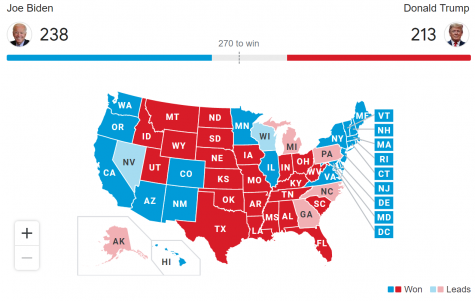2020 Presidential Election
 On Tuesday, November 3rd, 2020, Americans voted for the next President of the United States.
On Tuesday, November 3rd, 2020, Americans voted for the next President of the United States.
The 2020 Presidential Race features Republican Party candidate, President Donald Trump, competing against Democratic Party candidate, former Vice President Joe Biden.
Updates
—
As of 8:30 A.M. of November 4th, 2020, over 135 million people have voted, and here are the results:
Donald Trump (R) Electoral College Votes: 213
Joe Biden (D) Electoral College Votes: 238
—
As of 1:30 P.M. of November 7th, 2020, over 141 million people have voted, and here are the results:
Donald Trump (R) Electoral College Votes: 214
Joe Biden (D) Electoral College Votes: 290
*Note – the Associated Press has called this race for Candidate Joe Biden
—
Confused about how the electoral college system works or what the parties represent? We have compiled a list of frequently asked questions and answers to keep you informed about the Presidential Election.
FAQ:
2020 Presidential Election
What is the Electoral College and Electoral Votes?
A common misconception is that the Presidential Election is a popular vote, meaning everyone’s votes get tallied up together, and the candidate with the most overall votes wins the election. This is not the case. The United States utilizes a system known as the Electoral College to decide the next president. Under this system, each state is granted a predetermined amount of Electoral Votes based on their size and population. Whichever candidate wins by popular vote in a single state will receive all of that state’s Electoral Votes. This means that although one candidate may win the national popular vote, the other can still win via the Electoral College system. A presidential candidate needs 270 Electoral Votes to win. The total number of Electoral Votes in the United States is 538.
What is a swing state and why do they matter?
A swing state is a state within the United States where the Democratic and Republican parties have nearly identical levels of support. While most states have clearly defined political majorities, swing states are regarded as crucial for the Presidential Election because victories within these regions are unpredictable, and securing them would provide an advantage in Electoral Votes for the candidate’s campaign. Some examples of swing states for the 2020 Election include Florida, Michigan, Minnesota, Ohio, Texas, Wisconsin and more.
What are the Republican and Democratic Parties?
The Republican Party and Democratic Party are the two dominant political parties within the United States. A political party is a term for an organized group of people who share a similar ideology and work to elect candidates with similar views to accomplish their goals. While other political parties exist within the U.S., the Republican and Democratic Parties are the two largest and most influential ones. These two parties differ in opinion on a variety of topics, including philosophy, economic ideas, military issues and healthcare rights.
When will we know the results of the election?
This year’s Presidential Election is unique: the coronavirus pandemic has increased the use of mail-in ballots, different from in-person ballots which are filled out and submitted at a polling location. Because mail-in ballots take time to be sent in and counted, it might take more time than usual for election results to be determined officially. However, as more results emerge with each passing day, analysts can make predictions who will emerge victorious. Ultimately, the population will not know for certain until the U.S. Congress certifies the election results officially. During the last election cycle, this confirmation took place on January 6, 2017, while Election Day took place on November 8, 2016.
Why is November 3rd the designated date for Election Day?
The U.S. Congress sets the first Tuesday after the first Monday in November as the determined Election Day. This day takes place every two years, and always falls on an even year.
Do people only vote for the President on Election Day?
No, people also vote for the House of Representatives and the Senate on Election Day. Presidential Elections take place every four years, but U.S. House of Representatives and U.S. Senate Elections are held every two years. This means that every other Election Day, the U.S. President is elected alongside the House and Senate candidates.







